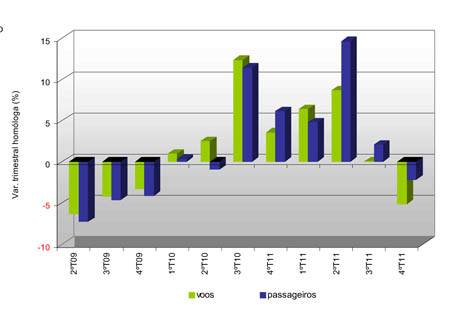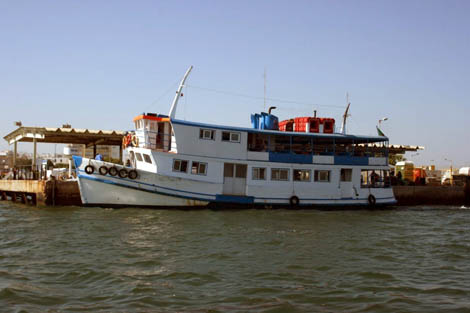 The section of the A2 in the Algarve region, the A22 and the railway, intra and interregional, registered a marked decrease in movement in the 4th quarter of 2011, compared to the same period of the previous year, according to data collected in the monitoring Regional Dynamics developed by the CCDR Algarve's Regional Dynamics Observatory.
The section of the A2 in the Algarve region, the A22 and the railway, intra and interregional, registered a marked decrease in movement in the 4th quarter of 2011, compared to the same period of the previous year, according to data collected in the monitoring Regional Dynamics developed by the CCDR Algarve's Regional Dynamics Observatory.
In fact, the widespread reduction in passenger movements and vehicle traffic in the 4th quarter of last year is really the dominant note that results from the analysis of these data, to which Sul Informação had access.
The exceptions to these generalized breaks in passenger movements and flows are the movement of passengers on the Ria Formosa routes (for reasons mainly related to the extension of the summer time during the month of October), the increase in Average Daily Traffic on the International Bridge do Guadiana, and the increase in the movement of passengers on urban highways and interregional highways.
The increase in the movement of passengers on these last connections reinforces the trend, already seen in previous quarters, of the loss of importance of the railway mode in interregional connections, which was heavily affected, also in the 4th quarter, by the number of strikes that took place.
The generalized drop in passenger movements and road flows in the Region, with only the exceptions mentioned above, prolongs, according to the Observatory, «the series of decreases observed in the various modes of transport in previous quarters, and it should also be noted that, in this 4th quarter, most of the decreases are even more pronounced than in previous quarters».
Particularly noteworthy are the sharp decreases in traffic on major regional routes – the section of the A2 in the region and the A22 – and also in the rail mode (intra and interregional).
Airport Faro with fewer passengers
 According to the same data, in the 4th quarter of 2011, the International Airport of Faro registered a movement of 7.015 flights and 925.720 passengers (both indicators referring only to commercial flights and passengers).
According to the same data, in the 4th quarter of 2011, the International Airport of Faro registered a movement of 7.015 flights and 925.720 passengers (both indicators referring only to commercial flights and passengers).
These figures represent falls compared to the same quarter (2010) of 5,2% (number of flights) and 2,2% (passenger movement).
The absolute values for the 4th quarter of 2011 are the lowest values for the same quarters of the four previous years (since 2007) and, in a way, represent a retraction in the increase in movements that had been registered for seven consecutive quarters - in the number of flights – and for five consecutive quarters – in the movement of passengers.
This even means that the trend of recovery, which had been taking place since the beginning of 2010, suffered a slight inflection, thus having to wait for the values of the movement in the coming quarters to determine whether the break in the last quarter of 2011 was a phenomenon conjunctural and isolated or, on the other hand, a longer period of stagnation (or retraction) of the air mode movement will have taken place.
Ria Formosa boats gain movement
 With regard to Maritime and Fluvial Transport, in the same period, the routes operating in the Ria Formosa transported a total of 78.190 passengers, which corresponds to an increase of 68,4% in relation to the same quarter of the previous year (4th quarter of 2010).
With regard to Maritime and Fluvial Transport, in the same period, the routes operating in the Ria Formosa transported a total of 78.190 passengers, which corresponds to an increase of 68,4% in relation to the same quarter of the previous year (4th quarter of 2010).
«This growth in relation to the same quarter of the previous year, undoubtedly very expressive, is mainly explained by the fact that the summer period, in 2011, lasted through the month of October», explains the Observatory.
For this reason, and as the Ria Formosa routes serve mainly to take the population to the beaches of the barrier islands, the month of October registered a much higher passenger movement than the same month of the previous year.
The bus crossing the Guadiana (Vila Real de Santo António – Ayamonte) carried a total of 25.743 passengers, which corresponds to a decrease of 4,6% compared to the same quarter of the previous year (4th quarter of 2010).
In the case of careers in Ria Formosa, the positive year-on-year change represents the resumption of a series of four consecutive quarters of positive quarterly changes, only interrupted by the 3rd quarter of 2010.
In the case of Guadiana's career, the values of the 4th quarter extend an already extensive succession of negative quarterly changes: at least 16 quarters in decline, since the 1st quarter of 2008.
On the other hand, in the 4th quarter of 2011, the regional rail system (Lagos – Vila Real de Santo António) transported a total of 403.354 passengers, which corresponds to a decrease of 8,5% compared to the same quarter of the previous year (2010 ).
The Long Distance (Alpha and Intercity services connections) handled a total of 106.613 passengers, which corresponds to a decrease of 17,4%.
In the case of the regional system, this is the fifth consecutive negative year-on-year change (since the 4th quarter of 2010). As for long-distance connections, there was a negative 7th quarterly variation (since the 2nd quarter of 2010).
Traffic decreases on the A2 and Via do Infante, but increases on the Guadiana Bridge
With regard to traffic on the main road axes, the data indicate that the Average Daily Traffic (TMD) in the terminal section of the A2 in the region (S. Bartolomeu de Messines – Paderne) was situated at 5.725 vehicles, which corresponds to one decrease of 21,9% compared to the same quarter of the previous year (2010).
On the A22/Via do Infante, on the other hand, TMD stood at 10.755 vehicles, which corresponds to a decrease of 24,0% in relation to the same quarter of the previous year (2010).
At the Guadiana International Bridge, TMD stood at 9.568 vehicles, which means an increase of 23,2%.
Both in the terminal section of the A2 and the A22, these are the fifth consecutive negative year-on-year quarterly changes (since the 4th quarter of 2010).
However, and in the case of the Guadiana International Bridge, the positive year-on-year change of 23,2% represents a very significant change in a succession of negative quarterly changes that already accounted for 11 quarters.
Buses transport more passengers on regional urban connections
 As for collective road transport, in the last quarter of last year, 354.633 passengers were transported in the Algarve on regional urban connections, which corresponds to an increase of 5,6% compared to the previous quarter (2010).
As for collective road transport, in the last quarter of last year, 354.633 passengers were transported in the Algarve on regional urban connections, which corresponds to an increase of 5,6% compared to the previous quarter (2010).
Long-distance connections carried a total of 1.626.536 passengers, which corresponds to a decrease of 6,0%.
Interregional connections ensured the transport of 169.565 passengers, corresponding to an increase of 3,4%.
International connections (Lagos – Seville route) carried a total of 4.119 passengers, which translates into a decrease of 2,1%.
In the case of urban connections, this quarter resumes a long series of consecutive positive quarterly variations, only interrupted by the 2nd and 3rd quarters of 2011.
In the case of long-distance calls, this negative quarterly variation is the 16th consecutive negative quarterly variation (at least since the 1st quarter of 2008).
As for interregional connections, this is the 4th positive quarterly variation, which reinforces the importance of the option to travel on the express service, to the detriment of the rail option, already mentioned in the 3rd quarter 2011 report.
Finally, and in relation to the movement in international calls, it was found that the values for the 4th quarter resume the downward trend already observed in the first two quarters of the year. However, due to the strong positive value of the 3rd quarter, the annual balance of this movement is positive.



















Comments